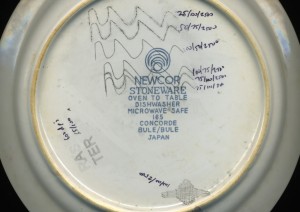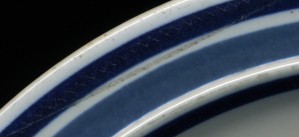lasering dishes
I wanted to see what would happen if I put a ceramic (stoneware) dish under the lazzzor. I started with the settings for etching glass, but the laser handbook only recommends raster settings, and I wanted to try vector engraving as well, so I tried a bunch of variations.

In the above image, I rubbed a bit of pencil graphite into the engravings to make them more visible. My favorite vector setting was 100% speed, 50% power (on the 35W Epilog). Slower speed or more power raised an ugly lumpy bead of molten glaze, but 100/50 gave a nice smooth scratch.
For my raster test (lower left in the image), I used the recommended settings for glass at 600dpi: 35% speed, 10% power. It looked just fine so I didn’t try any other settings.
I thought maybe I could melt through the colored glaze to reveal the white ceramic underneath, but that didn’t work.

The zigzag line in the above image was engraved at 75% speed/100% power, and the straight line at 14/100. Neither was able to make a white line through the blue glaze. I was afraid to go any slower, because there was already quite a lot of heat building up. Also, I’m thinking of doing this in bulk to a lot of dishes, so I’m ruling out any technique that goes slowly (and thus costs more).
Don't forget to put it on the wiki.
has anyone tried lasering on leather-hard clay vessels?
Are you in NYC, Robin? I'd love to experiment if you want to bring in some clay pieces. It's difficult to work with anything that's not mostly flat, so a plate is more practical than a vase.
I think we tried leather in the past, but it's not allowed anymore because it creates a horrible smell, and some tanned leather may release dangerous chemicals.
“leather-hard clay” is a descriptive term for clay that hasn't been through its first firing and still has some water content.
since it's basically sorta dry wet clay, i wonder if the laser could do anything besides evaporate the water in it–or basically end up “firing” it in places, which would be weird!
You need to get this stuff they use during burning to make the colors. It's a fine powder, if you manage to get a thin layer onto the surface before etching, you might end up with a colored line. Maybe wetten it a big to make it stick.
Please try out, I'm curious…